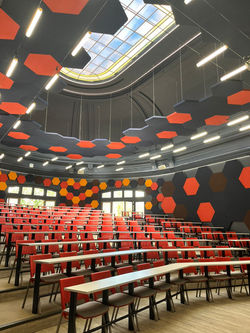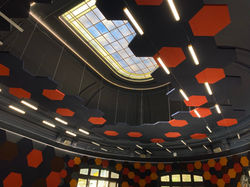AUDITORIUMS FCFM (Faculty of Physical and Mathematical Sciences) F10 & Q10
Interior remodeling and acoustic improvement project for both rooms due to the high pre-existing reverberation. The project was a team effort with acoustic engineers from IDIEM (Center for Research, Development and Innovation of Structures and Materials in Chile) that concluded by substantially improving the acoustic conditions of both classrooms, reducing their reverberation by almost 100%..
.
Among the elements that had to be combined is mainly acoustics, for which hexagonal panels were used in ceilings and side walls, which, upon acoustic contact, reduce reverberation. Another element was the aesthetics, where the color navy blue was used as a background to generate tranquility and concentration, contrasted with the panels with warm colors, which follow the line of the existing colors in the stained glass windows. Finally, the lighting, which responds to spatially marking the neoclassical moldings of the auditoriums and the dome; the side lights of walls to mark the stairs and panels; and the lighting of the sky aimed at students and teachers. .
 |  |  |  |
|---|---|---|---|
 |  |  |  |
 |  |  |
AUDITORIUM Q10
Professor Moisés Mellado´s Auditorium, owes its name to Professor Emeritus of the University of Chile and former academic of the Department of Physics of the Faculty of Physical and Mathematical Sciences (FCFM), who promoted the development of physics in Chile by forming the first generation of scientists and researchers in this discipline. This room is part of the history of the FCFM as it dates back to approximately 1930 and has a capacity to accommodate more than 100 people. The room is located on the first floor of the Mines Building (former Chemistry Building) and is twin to room F10.
AUDITORIUM F10
This room is named after Professor Igor Saavedra, a prominent researcher and academic at the FCFM whose relevant contribution to the development of theoretical physics and quantum mechanics meant that he received the National Science Prize in 1981. This auditorium was built in 1930, at the same time time than the building that houses it. It is one of the most traditional classrooms that the FCFM has and a place that brings a lot of nostalgia and memories to the graduates, since in that place controls and exams were carried out on large groups of students, mainly common plan students. The room is located on the first floor of the Physics Building, and is twin to room Q10..